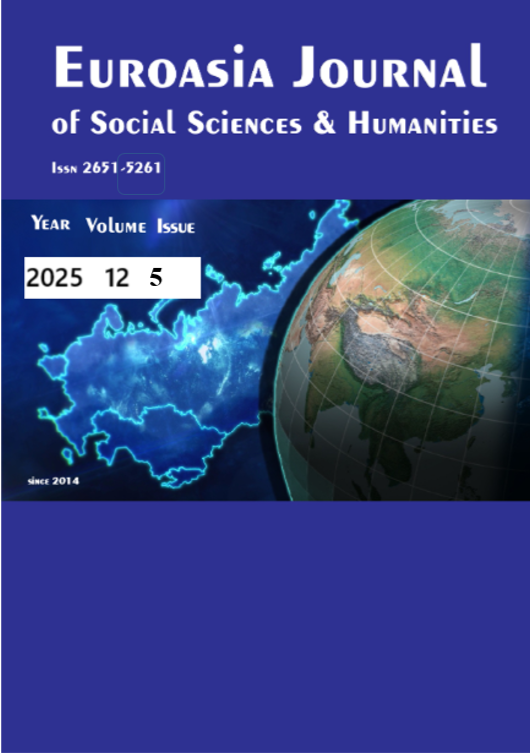Carpet-Kilim Art in the Turks and the Meaning of Motifs in the Context of Islamic Culture
DOI:
https://doi.org/10.5281/zenodo.17428177Keywords:
Anatolian Weaving Tradition, Motif Symbolism, Islamic Aesthetics, Sufism and Art, The Principle of TawhidAbstract
This study examines Turkish carpet and kilim art through its historical development, cultural context, and the spiritual and symbolic meanings conveyed by motifs within the context of Islamic culture. Developed by the Turks as a consequence of their nomadic lifestyle, starting in Central Asia, the art of weaving reflects a history spanning thousands of years, with early examples like the Pazyryk Carpet. Reaching its peak during the Great Seljuk and Ottoman periods, this art, with its aesthetic and functional value, has permeated a wide range of areas, from mosques and palaces to everyday life and international trade.
Carpets and kilims are not merely decorative objects; they are also carriers of social memory, belief, and identity. The textiles known as "Ölümlük" (death garments) used in funeral rituals are among the most striking examples of this cultural depth. With the adoption of Islam, the aesthetic approach to abstraction in art manifested itself in carpet and kilim motifs, with geometric patterns and stylized plant and animal figures becoming widespread.
One of the focal points of this study is the connection of these motifs with Islamic Sufism. The principle of monotheism is symbolically expressed in compositions based on central and infinite repetition; the idea of Unity of Being is expressed in holistic patterns where all motifs are interconnected; and the concept of Fena Fillah is symbolically expressed in motifs that simplify and intensify toward the center. Traditional motifs such as the hands-on waist, ram's horn, tree of life, mihrab, tulip, amulet, and waterway each carry profound meanings, symbolizing abundance, power, protection, qibla orientation, and divine unity.
In conclusion, Turkish carpet and kilim art, beyond mere technical perfection, is a cultural code and a means of spiritual expression passed down from generation to generation. Preserving this art form and its symbolic language is one of the most valuable cultural legacies to be passed down to future generations.
Downloads
References
Aslanapa, O. (1987). Türk Halı Sanatı'nın Bin Yılı. Eren Yayıncılık.
Aslanapa, O. (1982). Türk sanatı. Remzi Kitabevi.
Blair, S., & Bloom, J. (1995). The art and architecture of Islam 1250–1800. Yale University Press.
Burckhardt, T. (2009). İslam sanatı: Dil ve anlam (M. Y. Kılıç, Çev.). İnsan Yayınları.
BOZ, L Romanya’nın Transilvanya Bölgesi Protestan Kiliselerine Halı Bağışlama Geleneği, Vakıflar Dergisi 42 - Aralık 2014
Carswell, J. (2006). Islamic rugs and carpets. British Museum Press.
Çoruhlu, T. (2022). Kaynarca ve Kandıra dokumaları. Paradigma Akademi Yayınları.
Demirkan, M., & Sevgili Polat, Z. (2022). 17. Yüzyıldan günümüze goblen sanatı ve Grayson Perry eserlerinin incelenmesi. İletişim ve Sanat Dergisi, 3(5), 71-87.
Deniz, B. (1994). Türk dünyasında halı ve düz dokuma yaygı adetleri. Atatürk Kültür Merkezi Yayını.
Deniz, B. (2005). Anadolu-Türk halı sanatının kaynakları. Sanat Tarihi Dergisi, 14(1), 79-103.
Deniz, B. (2015). Türk halı ve kilim sanatında motif ve kompozisyon. Kültür ve Turizm Bakanlığı Yayınları.
Erdmann, K. (1970). Seven hundred years of oriental carpets. University of California Press.
Ergüder, A.A. (2007) Çoruh Vadisinde Düz Dokumalar. Oltu Ticaret ve Sanayi Odası Yayınları.
Flood, F. B. (2001). The great mosque of Damascus: Studies on the makings of an Umayyad visual culture. Brill.
Fonseca, J. (2005). The art of carpet weaving. Thames & Hudson.
Göknar, A. (2009). Ottoman art and architecture. Edinburgh University Press.
Kayıpmaz, F., Kayıpmaz, N., & Genç, M. (Ed.). (2022). Anadolu Türk halı kilim kültürü (SDÜ Yayın No. 117). Süleyman Demirel Üniversitesi.
King, D. (1986). Oriental rugs. Thames & Hudson.
Kıran, İ. (2014). Türk düğümü ve halı kuşağı. Türk Kültürü ve Hacı Bektaş Veli Araştırma Dergisi, 67, 75–88.
Sevgili Polat, Z., & Puran, F. (2023). Çintemani deseni: 15. ve 17. yüzyıllarda Osmanlı padişah ve şehzade kaftanları örneklemesi. VIII. Uluslararası Türk Kültür ve Sanatlarını Tanıtma Çalıştayı ve Sempozyumu, 1(1), 260-273.
Sevgili Polat, Puran, F, Z., & Zaimoğlu, O. (2025). Miniature-style paintings in the Kubbe-i Hadra section of the Mevlâna Museum. Problems of Engineering and Professional Education, 77(2), 7–27. https://bulprengpe.enu.kz/index.php/main/article/view/905
Sevgili Polat, Z. (2022). Antalya Etnografya Müzesi’nde bulunan icazetnamelerin tezhip bakımından değerlendirilmesi. Van Yüzüncü Yıl Üniversitesi Sosyal Bilimler Enstitüsü Dergisi, (58), 232–244.
Sevgili Polat, Z. (2023). Zarar Görmüş Yazma Eserlerin Konservasyon Aşamaları. Sanat Araştırmaları II. Gece Kitaplığı. 128-137.
Soysaldı, A. (2002). Türk kilimlerinde dokuma teknikleri ve boyama özellikleri. Hacettepe Üniversitesi Edebiyat Fakültesi Dergisi, 19(2), 203–216.
Ölçer, N. (1993). Kilim. Akbank Kültür ve Sanat Yayınları.
Ölçer, N. (1997). Halı sanatı. In T. D. Ögel (Ed.), Türk sanat tarihi (ss. 114–116). Kültür Bakanlığı Yayınları.
Ögel, B. (1991). Türk kültür tarihine giriş (Cilt 1–4). Kültür Bakanlığı Yayınları.
Parlak, T. (1999). Aral bölgesinde el halıcılığının geliştirilmesi projesi. Atatürk Üniversitesi & TİKA.
Yetkin, Ş. (1981). Türk halı sanatı. Türkiye İş Bankası Kültür Yayınları.
UĞURLU, S.S. (2021). Beyaz Zeminli Uşak Halılarından Bilinmeyen Bir Grup: Akrep Motifli Selendi Halıları.Journal of Turkish Studies, 2021-Volume 16 Issue 4, 1311-1333
Woolley, A. R. (2011). Ancient textiles. University of Pennsylvania Museum.
Zinder, C. (1992). Traditional Anatolian carpets. Schiffer Publishing.
Zor.Z.(2021) Nizami Gencevi’nin Hamsesinin Minyatür Sanatına Yansımaları. İletişim ve Sanat Dergisi, Yıl / Year: 2 Sayı/Issue: 4 Aralık / s.69-85
Zor.Z.(2023) TSMK’de Bulunan Osmanlı Safevi El Yazmalarının İki Örnek Üzerinden Tezhip Sanatı Açısından İncelenmesi. MAS JAPS Uygulamalı Bilimler dergisi 8(4): 717–728,
Zor, Z. (2025) Antalya Etnografya Müzesi’nde Bulunan 23.75.75 Envanter Numarasıyla Kayıtlı Hattat Seyyid Halil Şükrî Ye Ait Hilye-İ Şerifin Üslup Açısından İncelenmesi. Güzel Sanatlar Alanında Akademik Çalışmalar. S. 109-132
Görsel Kaynakça
https://hermitagemuseum.org/woa-search?lng=en&search=Pazyryk+carpet
Downloads
Published
How to Cite
Issue
Section
License
Copyright (c) 2025 EUROASIA JOURNAL OF SOCIAL SCIENCES & HUMANITIES

This work is licensed under a Creative Commons Attribution-NonCommercial 4.0 International License.

